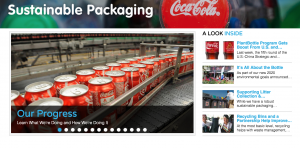Last week we learned that a company is able to achieve green growth through three different strategies. Accentuating its current green practices, acquiring other green brands, or architecting new green practices within the company.
Although these strategies seem straight forward, they have proved to be difficult to implement for many big names companies such as Coca-Cola. The company has put significant effort in building its social and environmental responsibility initiatives. To some extent I believe this can be seen as the ‘architect’ strategy where Coca-Cola is incorporating green growth into its operations, such as its initiative to implement sustainable methods of packaging and taking ownership of collecting its used bottles.

Furthermore, Coca-Cola has tried the strategy involving acquisition several times, but perhaps received more negative feedback than positive through this strategy. One recent example includes their acquisition of UK owned company Innocent drinks, which has garnered significant backlash and has consumers questioning whether the ethical ethos that set these drinks apart in the first place, will be lost.

The obvious problem of architecting and acquiring with companies like Coca-Cola, who have established themselves for being ‘big and bad’ is that the general public no longer believes that they introduce initiatives for altruistic reasons. Many of their efforts are simply dismissed as stemming from greed and being another means to generate profit.
I recently had a thought that perhaps the acquisition strategy would work more effectively if Coca-Cola looked to purchase smaller green focused companies that have less media attention and to work with them to make the brand successful. Although there would be significantly more risk with this strategy, it may just be able to silence some critics.
What do you think?

